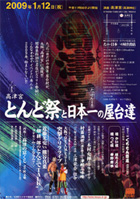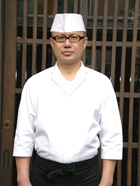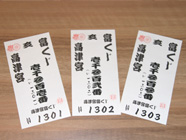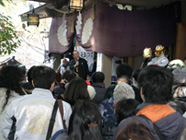|
|
|
|
|
 |
|
 |
|
"Kozu no tomi" is a popular monologue of classic rakugo (comic storytelling). It is about a man who is actually broke, but who nevertheless claims to be a super-rich merchant from the Tottori Region. The protagonist visits Osaka, and while staying at an inn, he brags of his wealth to the point that those around him believe that he actually has a lot of money. On hearing of his guest’s great wealth, the inn’s owner encourages his “rich” guest to participate in a tomikuji (lottery) event, conducted by the local Kozunomiya Shrine. In reality, however, all the man has in his pocket is one bu (a very small currency unit used during the Edo Period). This allows the man to buy the princely sum of a single lottery ticket. The man bottles up his courage and decides to buy the single ticket, while promising the inn proprietor that he will share half of any winnings. When the lottery is actually drawn, the inn owner learns that his guest has indeed won the grand prize of one thousand ryo (a considerable amount of money during the Edo Period). Carried away with fervor, the inn owner rushes back to the inn, darting into his guest's room while still wearing his sandals. As the man remonstrates with the inn owner about his poor manners (in still wearing his sandals), in his own panicky state he shakes out his futon, with the result that his own sandals fall out.
 As depicted in this rakugo monologue, a tomikuji event is still held today inJanuary of each year at Kozunomiya Shrine in Osaka’s Chuo Ward, as part ofComing of Age Day festivities (a national holiday in Japan). This event is part of the Tondo Matsuri (Festival). In addition to the lottery, the festival incorporates a number of events; these include food stalls set up by leading Osaka restaurants, rakugo performances, and live music. This festival has been attracting more and more visitors each year. The food stalls at the festival areespecially popular, with the public able try a wide variety of gourmet dishes, everything from French cuisine through to fugu (blowfish). Even dessertsare available. Moreover, the food, prepared by some of Osaka’s best restaurants, is offered at very reasonable prices (around 500 yen per serving). As depicted in this rakugo monologue, a tomikuji event is still held today inJanuary of each year at Kozunomiya Shrine in Osaka’s Chuo Ward, as part ofComing of Age Day festivities (a national holiday in Japan). This event is part of the Tondo Matsuri (Festival). In addition to the lottery, the festival incorporates a number of events; these include food stalls set up by leading Osaka restaurants, rakugo performances, and live music. This festival has been attracting more and more visitors each year. The food stalls at the festival areespecially popular, with the public able try a wide variety of gourmet dishes, everything from French cuisine through to fugu (blowfish). Even dessertsare available. Moreover, the food, prepared by some of Osaka’s best restaurants, is offered at very reasonable prices (around 500 yen per serving).
|
 |
|
 Kozunomiya Shrine’s Tondo Festival has been organized by Mr. Shigeo Nakamura, the owner of Nagahori, a popular izakaya in Osaka’s Uemachi District. Before lending his hand to this festival, Mr. Nakamura organized “kuromon yose,” a bimonthly rakugo event held in the Kuromon Ichiba shopping district of Osaka. He did this to offer support to the rakugo master, Bunshi Katsura, and his disciples. As a result of this activity, one day Mr. Nakamura was approached by a priest from Kozunomiya Shrine, who had heard about the “kuromon yose” event. The priest asked Mr. Nakamura to help the shrine hold a similar rakugo event. In the following summer, Mr. Nakamura helped open the first yose (rakugo event) at the shrine; this event featured the rakugo master, Bunshi Katsura, as its main attraction.
Kozunomiya Shrine’s Tondo Festival has been organized by Mr. Shigeo Nakamura, the owner of Nagahori, a popular izakaya in Osaka’s Uemachi District. Before lending his hand to this festival, Mr. Nakamura organized “kuromon yose,” a bimonthly rakugo event held in the Kuromon Ichiba shopping district of Osaka. He did this to offer support to the rakugo master, Bunshi Katsura, and his disciples. As a result of this activity, one day Mr. Nakamura was approached by a priest from Kozunomiya Shrine, who had heard about the “kuromon yose” event. The priest asked Mr. Nakamura to help the shrine hold a similar rakugo event. In the following summer, Mr. Nakamura helped open the first yose (rakugo event) at the shrine; this event featured the rakugo master, Bunshi Katsura, as its main attraction.
Mr. Nakamura next suggested a plan to start the Tondo Festival at Kozunomiya Shrine, as a new winter event for the annual calendar. Every winter, the shrine had previously held a traditional ceremony called otakiage, in which old New Year’s decorations were burnt in order to pray for good health in the coming year. Mr. Nakamura's idea was to expand on this event, developing a festival that incorporated new components. Besides rakugo performances, Mr. Nakamura wanted to launch an event that realized a "fusion of food and entertainment," by the bringing together a number of popular Osaka restaurateurs to act as food stall vendors. In the first year of this new festival, eight restaurants who enjoyed good relations with Mr. Nakamura agreed to participate in the event, each attracting their own regular clientele as visitors to the festival.
|
 |
 Mr. Nakamura gradually increased the scope of events offered at the Tondo Festival, believing that visitors to the festival would enjoy their festival experience more if they were “given a selection of events in the same timeslots from which they could choose.” He also worked closely with newspapers and magazines, having them run articles in order to raise the festival’s profile among Osaka residents. With an increasing number of people getting involved in the festival, the festival itself kept growing.
The current incarnation of the tomikuji lottery was introduced to the festival in 2005 by Mr. Nakamura, after one of his clientele suggested reintroducing this popular Edo Period tradition.
During the Edo Period, the tomikuji lottery offered a grand prize of one thousand ryo, over a billion yen by today’s standards. In the Edo Period, it is said that the precincts of the shrine became jam-packed with a mass of humanity on the day the lottery was drawn, it seeming as if "every soul in Osaka had congregated at the shrine in order to see the lottery winner." Since current laws do not allow for cash prizes in such lottery events, winners of the modern tomikuji lottery receive more modest prizes, including rice, Japanese sake, travel coupons, dinner tickets, electrical appliances, and so on. The drawing of the lottery occurs with a professional rakugo performer acting as the master of ceremonies. This person entertains the crowd with light, witty repartee.

Prior to the inaugural drawing of the modern "kozu no tomi" lottery, Mr. Nakamura asked the rakugo master, Bunshi Katsura, if he would perform the "kozu no tomi" monologue. Although hospitalized at the time fighting cancer, Bunshi was more than willing to leave his sick bed and perform this monologue. Unfortunately, Bunshi Katsura passed away a mere two months after appearing at the drawing of the "kozu no tomi" lottery. Indeed, his appearance at the event was his last public performance.
|
 |
After graduating from junior high school, Shigeo Nakamura worked at several restaurants before he opened his own establishment, Nagahori, in Shimanouchi, Osaka. He was 27 when this occurred, and the year was 1984. Since then, his goal of "serving tasty food at all times" has not deviated at all. In choosing ingredients for his business, Nakamura makes numerous visits to local food producers, only buying what truly satisfies him.
"It was about 15 years ago when I was teased by some of my friends from Tokyo and Sapporo," recalls Nakamura. "They said that other than takoyaki (octopus dumplings) and okonomiyaki (savory pancakes), no food in Osaka, whether it was French, Italian, soba, sushi, or traditional Japanese, truly tasted good. I found such comments both frustrating and strong motivating. These days, I eat at a host of different restaurants in order to better define what better taste means to me. I also have very good relations with those people who produce the food that I use as ingredients. My goal is to be totally committed to only serving menu at my own establishment that is truly delicious.”
Nakamura says that when he was an apprentice cook, it was uncommon that senior cooks would share their experiences and cooking knowledge with younger colleagues. In those days, the only way by which young cooks could improve their skills was for them to study by themselves.
"I wanted to act the complete opposite in terms of how I worked with young cooks and other restaurant owners,” says Nakamura. "I began introducing these people to reliable producers, wholesalers, and media people, who I already knew. In return, I was able to build a really good relationship with younger generations within the restaurant trade. This relationship has become the basis of what is now the Tondo Festival."
This year's Tondo Festival was held under sunny skies on January 12th, and it attracted between 30,000 and 40,000 people to Kozunomiya Shrine. Crowd numbers prove that the festival, which is both based on local popular traditions, and supported by highly motivated local partners, is steadily growing into one of Osaka’s most popular events.. |
|
|
|
|
Febrary
26, 2009
Hiroshi Yamanou, Osaka Brand Center
|
|
|
|
